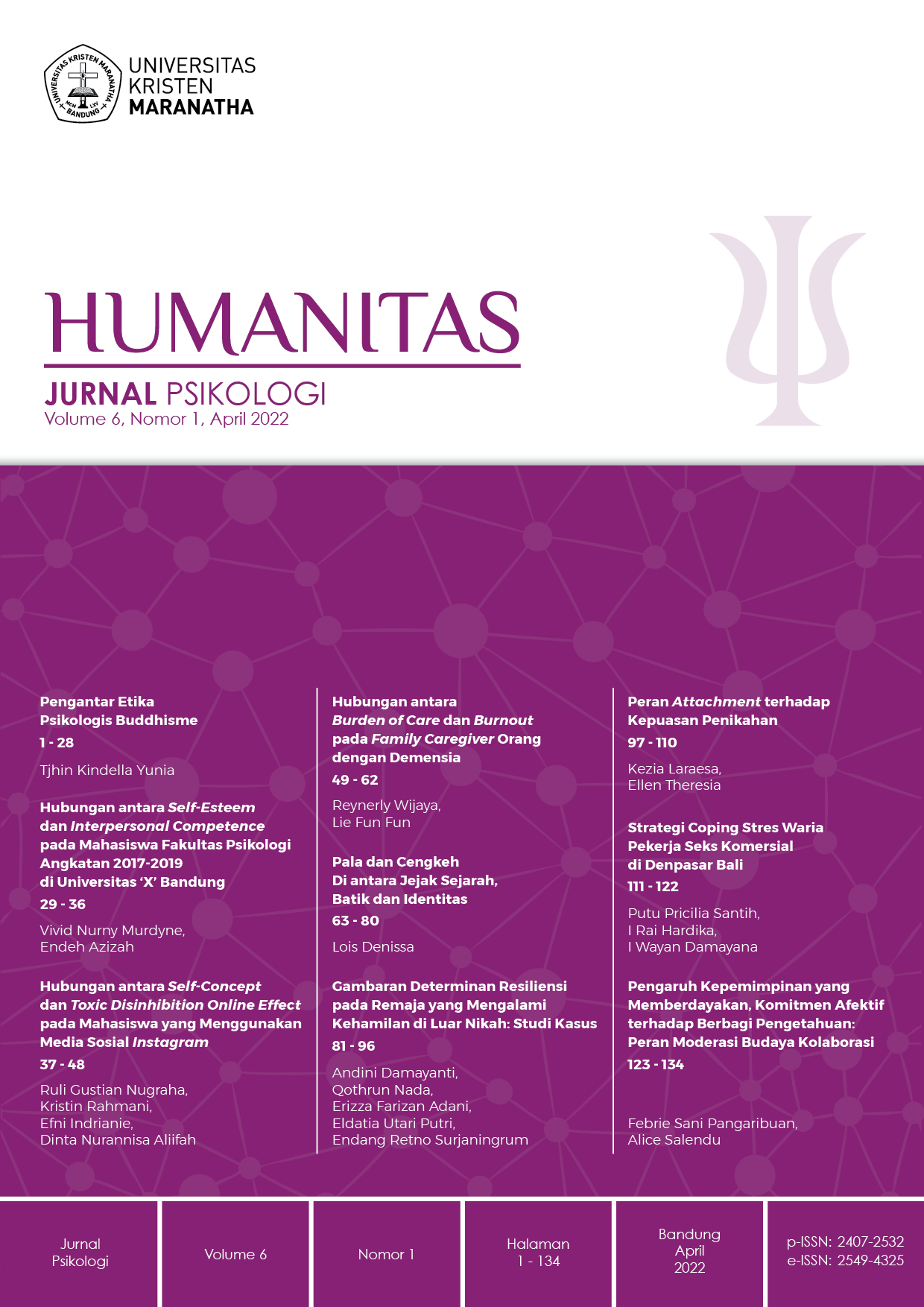Peran Attachment terhadap Kepuasan Penikahan
Isi Artikel Utama
Abstrak
Unduhan
Rincian Artikel

Artikel ini berlisensi Creative Commons Attribution-NonCommercial 4.0 International License.
Referensi
Ayenew, E. (2016). The Effect of Adult Attachment Style on Couples Relationship Satisfaction. The International Journal of Indian Psychology, Vol. 3, Issue 2, No. 3
Badan Pusat Statistik. (2019). Statistik Indonesia Statistical Yearbook Of Indonesia. Indonesia: Badan Pusat Statistik/ Bps-Statistics Indonesia
Badan Pusat Statistik Kota Bandung. (2019). (https://bandungkota.bps.go.id/statictable/2020/07/27/988/persentase-perempuan-di-kota-bandung-yang-pernah-kawin-menurut-umur-perkawinan-pertama-2019.html), diaskses Oktober pada 2020, pukul 20.38 WIB
Banse, R. (2004). Adult Attachment and Marital Satisfaction: Evidence for Dyadic Configuration Effect. Journal of Social and Personal Relationship 21:273
Bartholomew, K. & Horowitz, L. M. (1991). Attachment styles among young adults: A test of a four-category model. Journal of Personality and Social Psychology, 61(2), 226-244.
Bowlby, J. (1973). Attachment and loss: Vol. 2. Separation: Anxiety and anger. New York: Basic Books.
Collins, N. L. & Read, S. J. (1990). Adult Attachment, Working Models, and Relationship Quality in Dating Couples. Journal of Personality and Social Psychology, Vol. 58, No. 4,664-663
Diamond, R. M., Brimhall, A. S., & Elliott, M. (2018). Attachment and Relationship Satisfaction among First Married, Remarried, and Post-Divorce Relationship. Journal of Family Therapy (2018) 40: S111-S127
Fowers, B. J. & Olson, D. H. (1993). ENRICH Marital Satisfaction Scale: A Brief Research and Clinical Tool. Journal of Family Psychology, Vol. 7, No. 2, 176-185
Hajizah, Y. N. (2012). “Hubungan Antara Komunikasi Intin Dengan Kepuasan Pernikahan Pada Masa Pernikahan 2 Tahun Pertama” (Skripsi). Fakultas Psikologi Universitas Indonesia: Depok.
Hazan, C., & Shaver, P. (1987). Romantic Love Conceptualized as an Attachment Process. Journal of Personality and Social Psychology, 52(3), 511–524
Mustafa, H., Hasim, M. J. M., Aripin, N. & Hamid, H. A. (2013). Couple Types, Ethnicity and Marital Satisfaction in Malaysia. Applied Research in Quality of Life. 8. 10.1007/s11482-012-9200-z.
Meyers, S. A. & Landsberger, S. A. (2002). Direct and indirect pathways between adult attachment style and marital satisfaction. Personal Relationship, 9 (2002), 159-172
Riza, W. L. (2018). Asosiasi Antara Attachment Styles Dalam Hubungan Romantis Pada Relationship Satisfaction (Kepuasan Dalam Suatu Hubungan). Pyschophedia Jurnal Psikologi Universitas Buana Perjuangan Karawang
Santrock, J. W. (2011). Life-Span Development Thirtheen Edition. New York: The McGraw-Hill, Inc
Scharfe, E. (2016). Measuring what counts: Development of a new four-category measure of adult attachment. Personal Relationshiop, 23 (2016), 4-22
Srisusanti, S. & Anita Z. (2013). Studi Deskriptif Mengenai Faktor-faktor yang Mempengaruhi Kepuasan Perkawinan Pada Istri. UG Jurnal, Vol. 7 No. 06 Tahun 2013, 08-12
Tavakol, Z., Nasrabadi, A. N., Moghadam, Z. B., Salehiniya, H., & Rezaei, E. (2017). A Review of the Factors Associated with Marital Satisfaction. Galen Medical Journal, 6(3), 197-207. (https://www.gmj.ir/index.php/gmj/article/view/641/html), diunduh pada Februari 2021, pukul 18.35 WIB
Undang-Undang Republik Indonesia tentang Perkawinan. (1974). Pemerintah Republik Indonesia

